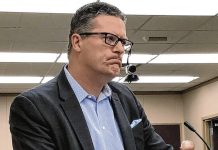Columbus has increased its cumulative capital development tax rate to the maximum allowed by the state over objections of several local residents who described the vote as “picking taxpayers’ pockets.”
The Columbus City Council voted 5 to 2 to increase the rate, with Council President Frank Miller and Councilwoman Laurie Booher voting no.
The tax rate, one of seven that makes up the overall city tax rate, will increase from $0.0316 to the state maximum of $0.05 per $100 in assessed value. The current tax rate brings in $786,068 per year for the city — and increasing the rate will bring in $815,414.
If the proposed increase is approved, a homeowner with a residence assessed at $150,000 would pay an additional $13.50 in property taxes, while someone with a $200,000 home would pay about $18 more a year. Taxpayers already at the maximum property tax would see no increase, however.
City officials want to use the cumulative capital fund money to pay for capital expenses for the police and fire departments during the next five years. Police Chief Jon Rohde said in an earlier interview his department plans to replace 60 body cameras under a plan that would also provide unlimited cloud-based data storage that is estimated to cost $92,000.
In addition, the department also plans to replace 14 police vehicles that will cost $550,000 as part of a fleet-rotation cycle. The agency’s other needs include $100,000 to make the final payment of a three-year contract for portable radios, Rohde said.
The fire department has identified $880,000 in fire apparatus equipment and $325,000 in fire station alerting system software among its needs, said Jamie Brinegar, finance director for the city, in an earlier interview. The city plans to identify which items will be paid through the cumulative capital fund during the 2018 budget process, he said.
Columbus’ current cumulative capital fund has been in existence since 1987, but has not been set as the maximum level during the past 12 years, Brinegar said, adding that the Indiana Department of Local Government Finance recommends cities set the rate to the maximum level to obtain necessary revenue for capital needs.
Resident Russell Poling of Columbus said the increase would put undue strain on taxpayers with fixed incomes. He said the city should stop spending money on consultants and use that money instead for the capital expenses.
“This increase will hit people who can least afford it,” said Glen Petrie of Columbus. Describing the items the money would be used for as wants rather than”needs, he said the council was about to “pick the pocket of people.”
“When does it end?” David Jones of Columbus asked the council.
Jones said the city should be using its Rainy Day Fund to pay for firetrucks, police cars and body cameras instead of increasing taxes.
City Councilman Dascal Bunch said the reason for the increase is that the capital expenditures that were mentioned have been put off for so long, there is no longer a choice about spending the money.
“We inherited this,” he said of having to replace equipment that had not been replaced under a former administration.
Brinegar told the residents that the Columbus tax rate had actually decreased from 2016 to 2017 and the cumulative capital fund is only one rate among seven that makes up the total city tax rate. Brinegar said the city’s goal will be to have decreases among the other six tax rates to offset the increase in the cumulative capital fund and have the overall tax rate remain steady or go down with the next budget cycle.




